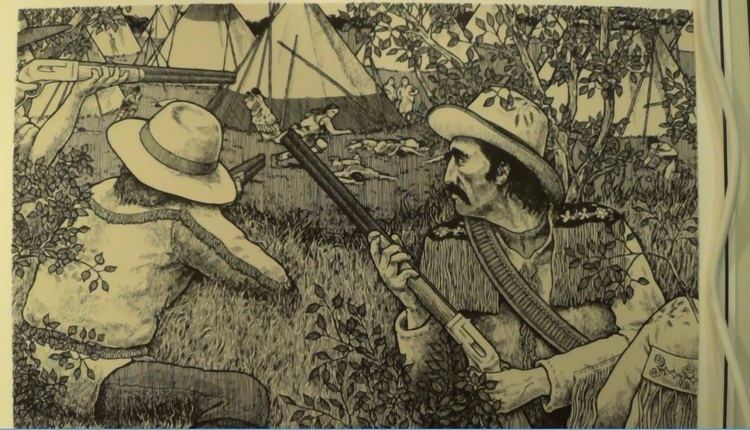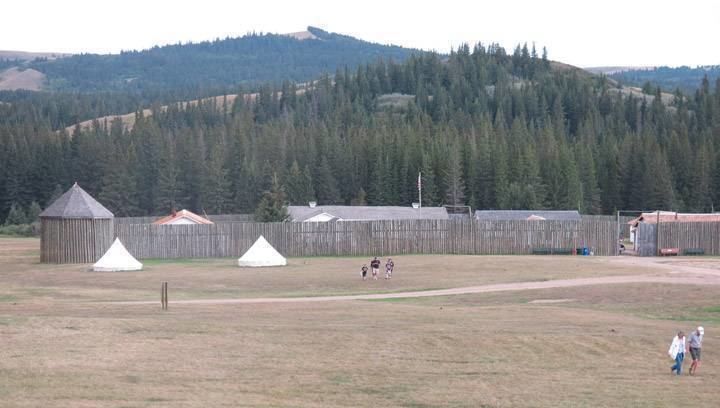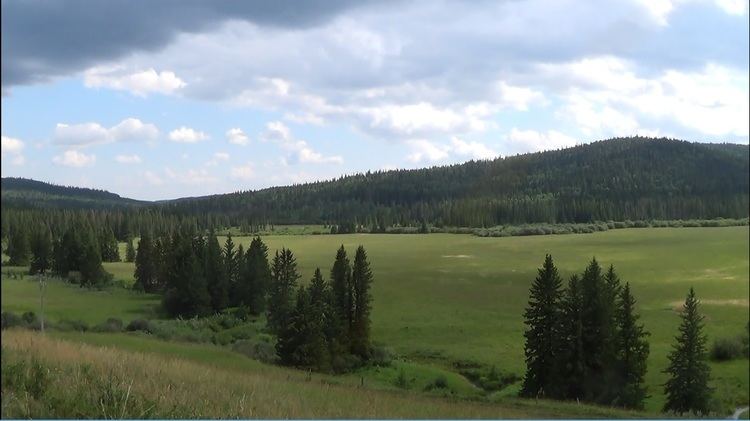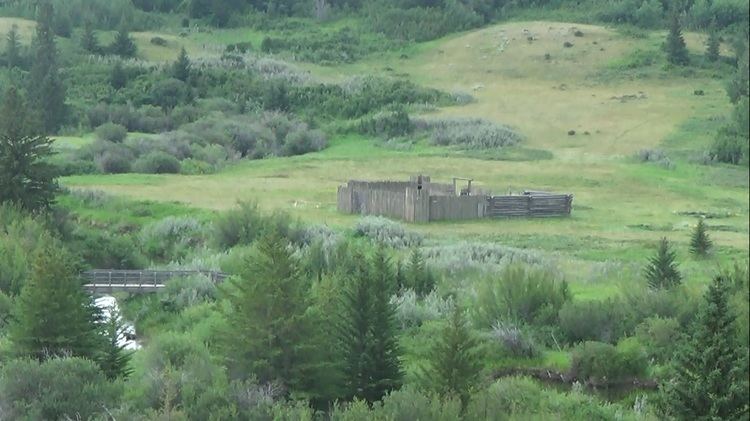Designated 1 January 1964 | Year of event 1873 Start date June 1, 1873 | |
 | ||
Nearest city Rural Municipality of Maple Creek No. 111 | ||
The m tis of fort walsh and cypress hills massacre national historic sites
The Cypress Hills Massacre was a mass murder that occurred on June 1, 1873, in the Cypress Hills region of Battle Creek, North-West Territories (now in Saskatchewan). It involved a group of American bison hunters, American wolf hunters or 'wolfers', American and Canadian whisky traders, Métis cargo haulers or 'freighters', and a camp of Assiniboine people. An estimated twenty or more Natives and one wolfer died. The Cypress Hills Massacre prompted the Canadian government to accelerate the recruitment and deployment of the newly formed North-West Mounted Police to prevent further conflict.
Contents
- The m tis of fort walsh and cypress hills massacre national historic sites
- Incident
- Aftermath
- Trial and investigation
- Creation of the North West Mounted Police
- In media
- In fiction
- References

Incident

The incident began in the spring of 1873 when a small party of Canadian and American wolfers, led by Thomas W. Hardwick and John Evans, were returning from their winter hunt. While they camped on the Teton River a group of unknown Natives stole their horses. After determining that their horses were indeed stolen the men travelled to Fort Benton, Montana Territory, about five miles, with the intention of regaining their horses. At Fort Benton the wolfers pleaded for assistance and justice for the crimes against them, but were met with a refusal by the local military commander. On their own, the men began an expedition to retrieve the stolen horses. The party numbered 13 men, a collection of American and Canadian free traders. Described as typical frontiersmen, the group had had previous conflicts with Natives and were unwilling to seek peace. They were prepared to use violence to retrieve their stolen property.

The group quickly travelled from Fort Benton northward across the border in pursuit of the stolen horses. They eventually arrived at Abe Farwell’s post, a small trading post located within the Cypress Hills region. While the group was there they met up with George Hammond, an unsavoury figure who had recently been selling whisky to the Natives with Farwell. Hammond was close friends with John Evans and Thomas Hardwick, the leaders of the group, and subsequently joined with the other wolfers in the search for the horses. Farwell assured Evans that Little Soldier, the leader of a small band of Assiniboine that was located near the trading post, had no horses with them. After a brief search it was determined by the group that Little Soldier showed no evidence that he stole their horses. Evans, Hammond, and the rest of the wolfers retired for the night at Farwell’s trading post. The gang spent the evening and the next morning drinking Farwell’s whisky with a group of recently arrived Métis freighters. In the morning it was believed that one of Little Soldier’s men had stolen George Hammond’s horse for a second time.

In response, Hammond grabbed a rifle and started towards Little Soldier’s camp. He insisted that the rest of the wolfers join him and forcibly take back his horse. The wolfers, along with the Métis, followed Hammond towards the Assiniboine camp. Historical accounts differ on what happened during the skirmish, as there were no reliable testimonies. Abe Farwell testified that he tried to restrain Hammond in an attempt to avoid any violence. Hammond approached Little Soldier’s tent asking about the missing horse. Little Soldier replied that his group had not stolen the horse but that it was grazing on a nearby hill. Both Little Soldier and Hammond’s parties were intoxicated and negotiations between them fell through. Little Soldier was willing to avoid violence and gave Hammond two of his horses as hostage until the missing horse could be found. This did not avoid violence as the situation became increasingly tense as women and children were seen fleeing from the camp, and the Native men taking off their garments in preparation for violence. The wolfers regarded these actions as a signal for a fight and lined up along a riverbank fifty yards outside the Assiniboine camp. Seeing these preparations, Little Soldier asked Hammond why his group were taking such menacing positions. In a last ditch effort to avoid violence Farwell pleaded with the wolfers, asking them not to shoot at the Natives especially when there was a white man among them. Before he could continue negotiating with Little Soldier and the wolfers, Farwell saw Hammond fire his rifle at the Natives. The rest of the wolfers, protected by the tall river bank, fired volleys onto the camp. The Assiniboine, using inferior weapons, attempted to return fire but were unable to sustain an attack due to the wolfers superior position and surprise. They did manage to kill one wolfer, a French Canadian named Ed Legrace. The number of casualties differs from accounts but the number of Assiniboine deaths was higher than twenty. In the personal account of Donald Graham, who joined the wolfers at Fort Benton and travelled with them to Cypress Hills, mentions that there were only 13 Indians dead. After the battle, the wolfers buried Legrace in a Native cabin and set the building ablaze. His wooden coffin still remains there to this day.

The site of the massacre was designated a National Historic Site of Canada in 1964. Artifacts from the Cypress Hills Massacre have also been preserved at nearby Fort Walsh National Historic Site, along with reconstructions of Farwell's and Solomon's trading posts.
Aftermath

News of the Cypress Hills Massacre did not reach Ottawa until late August 1873, therefore the event itself was not very well known in Canada. The Canadian government soon took steps to have those involved extradited from the United States and tried for the murders, causing confrontation between Canada and the United States. The case for the murders languished for some time and then was taken up by the newly created North-West Mounted Police (NWMP). The NWMP at this time was still establishing itself, and the Cypress Hills Massacre acted as a catalyst for the speedy transition to react appropriately to the consequences.
Trial and investigation
In December 1874, Assistant Commissioner James Macleod was given permission by the United States Government to enter Helena, Montana to start an investigation into the Cypress Hills Massacre. Due to the findings of this investigation, the accused would face extradition to Canada to face punishment. Only seven arrests were made, but two men escaped custody before they could stand trial. The remaining defendants were acquitted. The prosecution’s case was weak due to the fact that there was not enough clear evidence to prove anything the wolfers. The American commissioner refused the extradition request as there was far too much conflicting testimony for a conviction. As a result, the acquitted men charged Macleod with false arrest. This charge was soon dropped, as Macleod was on American soil with the permission of the U.S. government. Shortly after they were released, two traders and a wolfer were then arrested in Canada and tried in Winnipeg in June 1876. The government once again weakened the case by insufficient or contradictory evidence, and the three men were acquitted. The case was finally dropped in 1882 due to conflicting evidence. Therefore, the courts never sentenced the men that caused the Cypress Hills Massacre.
W.E. Cullen, the American Commissioner, said at the extradition hearing at Helena: although the “preponderance of testimony is… to the effect that the Indians commenced the firing… they were doubtlessly provoked to this by the apparently hostile attitudes of the whites… An armed party menacing their camp, no matter for what purpose, was by no means slight provocations.” While the killing may not have been premeditated, there was no excuse for its wantonness; however, this can be explained that the Assiniboine people were victims of racial prejudice. General Phil Sheridan who was a U.S. Army officer and Union general, had a philosophy of shooting first especially when it involved Indians. The Cypress Hills Massacre demonstrated the vulnerability of life, especially the Native life, on the Canadian frontier also involving the United States having only a negative impact.
Creation of the North-West Mounted Police
It is very difficult to measure the impact that the Cypress Hills Massacre had on Canada and the United States. The creation of the North-West Mounted Police, later named the Royal Canadian Mounted Police, was introduced partially as a result of the massacre. Second Lieutenant Governor of Manitoba, Alexander Morris, was concerned about perceived threats of violence to uniformed Canadians and Americans conducting geological surveys. As a result, Morris had to call off any further surveying until there was a solution. Unable to find a solution, Morris used recent American reports of the massacre, and called for Prime Minister John A. Macdonald to create a police force. Already planning to establish a police force in the North-West Territories, Macdonald had envisioned a horse mounted brigade based on the idea of the Royal Irish Constabulary. The force would be small; only 300 men could enlist. For an area that covered 480 000 square kilometres, the force would have to be as mobile as possible. Alexander Campbell, the minister of the interior, did not believe sending an armed police force into the North-West Territories was necessary at this time. Morris, feared that if ice covered the paths the police would not report until next year, causing a delay in training and deployment. To force their creation, Morris claimed that the Métis and white settles in the area around Portage la Prairie and Qu’Appelle were experiencing fear and unrest due to the massacre. On September 25, 1873, the government of Canada passed an order-in-council to appoint nine officers of “Mounted Police Force for the North-West Territories". Recruitment began immediately, and the North-West Mounted Police was created. With the new police force patrolling the area, the border could no longer be so easily crossed.
The creation of the police force also had a political motive. The investigation into the massacre was to ensure that First Nations in the area were able to trust the Canadian government. The investigation would require cooperation of two federal governments, and the North-West Mounted Police would take measures to make examples out of international criminals. Although ultimately no prosecution took place, the willingness to seek justice for any Canadian contributed to the establishment of peace between the NWMP and First Nations.
As time went on the Cypress Hills Massacre gradually became part of popular knowledge about Canada’s past even though the event was never fully closed and dealt with.
In media
When the news of the Cypress Hills Massacre broke into eastern Canada, it introduced a wave of anti-Americanism. In the news, the American men were described as "American gangsters" and "American scums". The idea that only American frontiersmen could commit this outrage had been maintained in many Canadian written accounts of the massacre. Canadians were not only shocked that the Americans committed such a crime in their country, but now the media was putting an increased negative view on Americans. Canadians believed that Americans would continually murder people on Canadian soil. This fear was summed up by General Philip Sheridan’s infamous statement to Tosawi of the Comanche, "The only good Indians I ever saw were dead."
Although Canadians also took part in the Cypress Hills Massacre, it remains overlooked in western Canadian history. Even though it took place in Canada, the massacre represented a temporary extension of American frontier mentality into the Canadian North-West.
In fiction
A fictionalized account of the events of the Cypress Hills Massacre is told in the novel The Englishman's Boy by Canadian author Guy Vanderhaeghe. The story focuses in part on the character of the "Englishman's boy", one of the members of the party of wolfers. While little is known of those involved in the actual event, the novel attributes the cause of the massacre to one Tom Hardwick, the "lead" wolfer. The book was made into a miniseries that first appeared on CBC Television in March 2008.
The movie The Canadians was another fictionalized version. The Cypress Hills Massacre is also used as the plot centrepiece for the Terrance Dicks novel Massacre In the Hills which charts the beginning of the NWMP.
